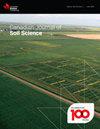Mapping the maximum peat thickness of cultivated organic soils in the southwest plain of Montreal
IF 1.5
4区 农林科学
Q4 SOIL SCIENCE
引用次数: 5
Abstract
Abstract Large organic deposits in the southwestern plain of Montreal have been converted to agricultural land for vegetable production. In addition to the variable depth of the organic deposits, these soils commonly have an impermeable coprogenous layer between the peat and the underlying mineral substratum. Estimations of the depth and thickness of these materials are critical for soil management. Therefore, five drained and cultivated peatlands were studied to estimate their maximum peat thickness (MPT)—a potential key soil property that can help identify management zones for their conservation. MPT can be defined as the depth to the mineral layer (DML) minus the coprogenous layer thickness (CLT). The objective of this study was to estimate DML, CLT, and MPT at a regional scale using environmental covariates derived from remote sensing. Three machine-learning models (Cubist, Random Forest, and k-Nearest Neighbor) were compared to produce maps of DML and CLT, which were combined to generate MPT at a spatial resolution of 10 m. The Cubist model performed the best for predicting both features of interest, yielding Lin’s concordance correlation coefficients of 0.43 and 0.07 for DML and CLT, respectively, using a spatial cross-validation procedure. Interpretation of the drivers of CLT was limited by the poor predictive power of the final model. More precise data on MPT are needed to support soil conservation practices, and more CLT field observations are required to obtain a higher prediction accuracy. Nonetheless, digital soil mapping using open-access geospatial data shows promise for understanding and managing cultivated peatlands.绘制蒙特利尔西南平原栽培有机土壤的最大泥炭厚度
摘要蒙特利尔西南平原的大型有机矿床已被转化为蔬菜生产的农业用地。除了有机沉积物的深度可变外,这些土壤通常在泥炭和下层矿物基质之间有一层不可渗透的共生层。估计这些材料的深度和厚度对于土壤管理至关重要。因此,对五个排水和耕种的泥炭地进行了研究,以估计其最大泥炭厚度(MPT)——这是一种潜在的关键土壤特性,有助于确定保护泥炭地的管理区。MPT可以定义为到矿物层的深度(DML)减去共生层厚度(CLT)。本研究的目的是使用遥感得出的环境协变量在区域尺度上估计DML、CLT和MPT。比较了三个机器学习模型(Cubist、Random Forest和k-Nearest Neighbor),以生成DML和CLT的地图,将其组合以生成10m空间分辨率的MPT。Cubist模型在预测两个感兴趣的特征方面表现最好,DML和CL的Lin一致性相关系数分别为0.43和0.07,使用空间交叉验证程序。CLT驱动因素的解释受到最终模型预测能力差的限制。需要更精确的MPT数据来支持土壤保护实践,需要更多的CLT现场观测来获得更高的预测精度。尽管如此,使用开放获取地理空间数据的数字土壤测绘显示出了解和管理耕种泥炭地的前景。
本文章由计算机程序翻译,如有差异,请以英文原文为准。
求助全文
约1分钟内获得全文
求助全文
来源期刊

Canadian Journal of Soil Science
农林科学-土壤科学
CiteScore
2.90
自引率
11.80%
发文量
73
审稿时长
6.0 months
期刊介绍:
The Canadian Journal of Soil Science is an international peer-reviewed journal published in cooperation with the Canadian Society of Soil Science. The journal publishes original research on the use, management, structure and development of soils and draws from the disciplines of soil science, agrometeorology, ecology, agricultural engineering, environmental science, hydrology, forestry, geology, geography and climatology. Research is published in a number of topic sections including: agrometeorology; ecology, biological processes and plant interactions; composition and chemical processes; physical processes and interfaces; genesis, landscape processes and relationships; contamination and environmental stewardship; and management for agricultural, forestry and urban uses.
 求助内容:
求助内容: 应助结果提醒方式:
应助结果提醒方式:


